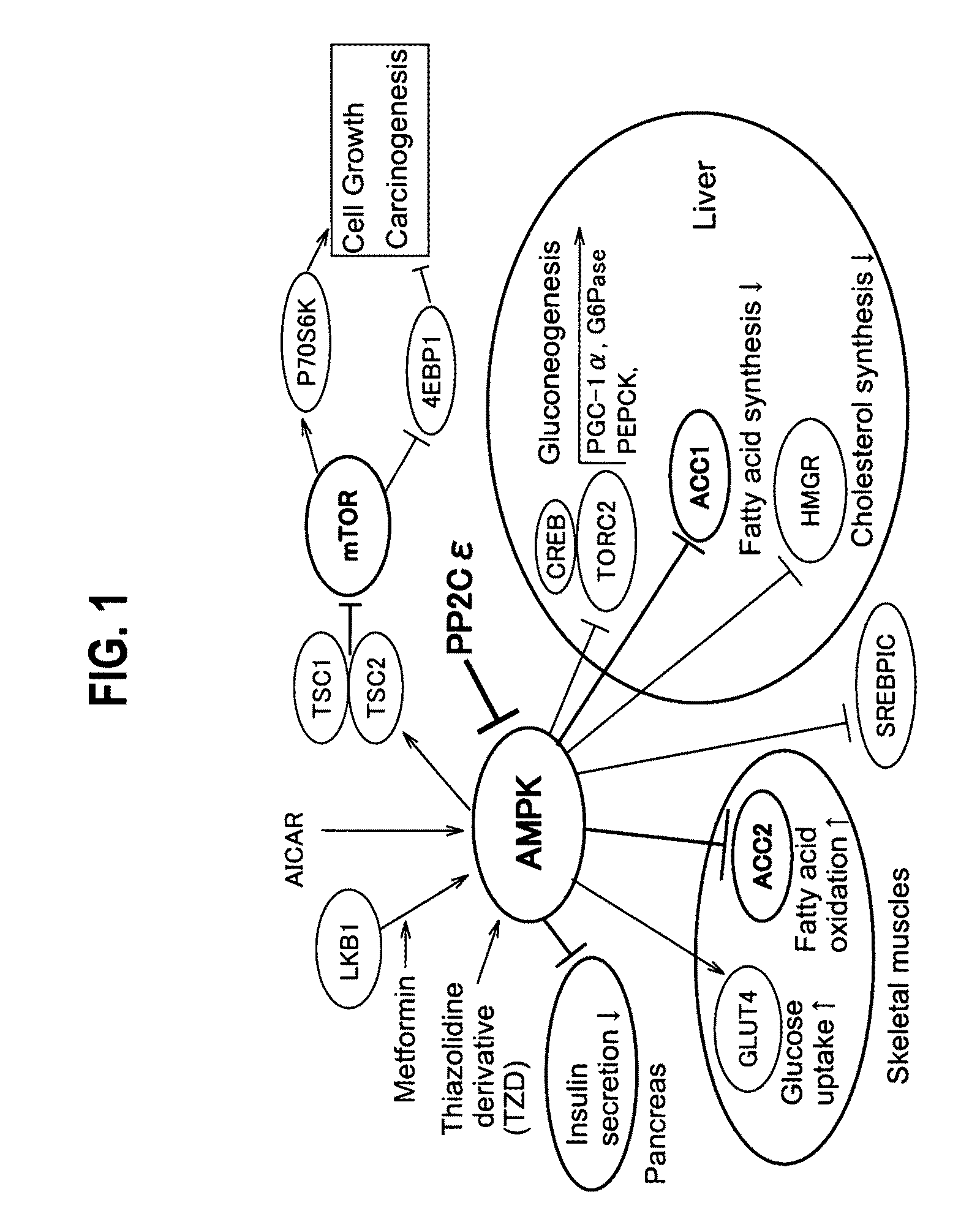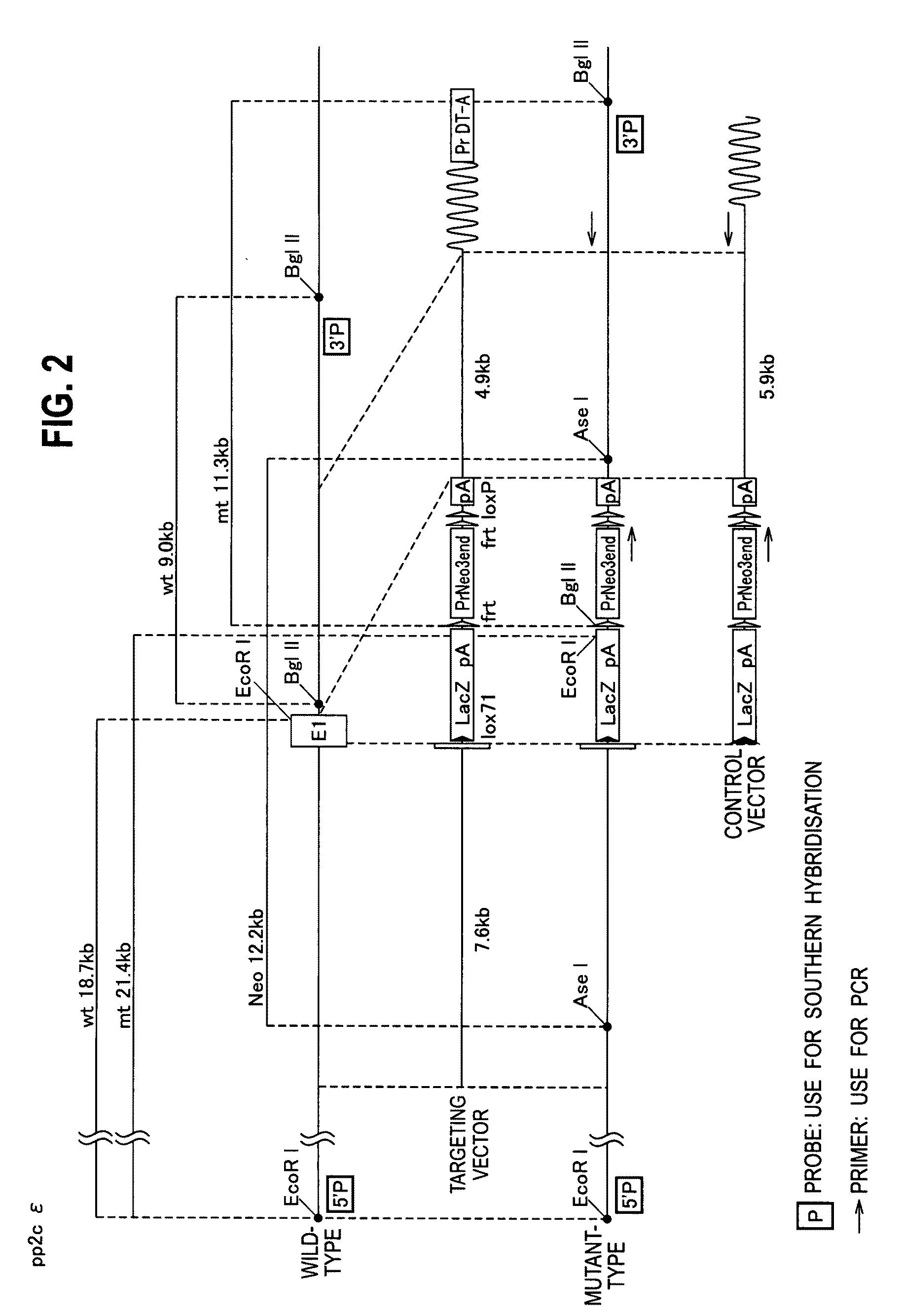Use of protein phosphatase 2Ce (PP2Ce) having dephosphorylating action on AMPK
a technology of protein phosphatase and ampk, which is applied in the direction of peptides, drug compositions, metabolic disorders, etc., can solve the problem that the demand for control of ampk diseases cannot be satisfied by the conventional ampk activator
- Summary
- Abstract
- Description
- Claims
- Application Information
AI Technical Summary
Benefits of technology
Problems solved by technology
Method used
Image
Examples
example 1
Creation of PP2Cε Knockout Animal
[0103]FIG. 2 shows construction and homologous recombination of a target (Targeting Vector / TV). As shown in FIG. 2, an EX1 region of PP2Cε gene was replaced by promoter-less lacZ gene (SEQ ID NO: 4) and a positive selection marker neomycin resistance gene (SEQ ID NO: 5), to crease a PP2Cε knockout mouse (SEQ ID NO: 1) wherein the PP2Cε locus was ruined.
[0104]Southern blot analysis of homologously recombined ES clone was carried out under the following conditions. A 5′-probe was used for DNA digested with EcoRI, a 3′-probe was used for DNA digested with BgIII, and neomycin (Neo) probe was used for DNA digested with Ase. As ES cells, TT2 strain was used. FIG. 3 shows a profile in Southern blotting. DNAs in wild-type (+ / +) and mutant ES cell (+ / −) shown in FIG. 3 were confirmed to show signals at expected positions, respectively.
[0105]The DNA digested with EcoRI was analyzed in Southern blotting with the 5′-probe in genomic DNA purified from a mouse tai...
example 2
Observation of Phenotype of PP2Cε Knockout Mouse
[0106]To confirm the phenotype of PP2Cε knockout mouse, the phenotype of wild-type (PP2Cε+ / +) mouse was compared with that of homo (PP2C− / −) mouse. The photographs show wild-type (PP2Cε+ / +) and homo (PP2Cε− / −) male litter mice within 24 hours after birth (FIG. 5) and one-week-old (FIG. 6), four-week-old (FIG. 7) and one-year-old (FIG. 8) wild-type (PP2Cε+ / +) and homo (PP2Cε− / −) male litter mice, respectively. In FIGS. 5 to 8, the wild-type (PP2Cε+ / +) male mouse shown in the left and the homo (PP2Cε− / −) male mouse in the right. As shown in FIGS. 5 to 8, the weight of the created homo (PP2Cε− / −) mice had been lighter from birth than the wild-type (PP2Cε+ / +) litter mice.
[0107]As shown in FIG. 9, the survival rate of the homo (PP2Cε− / −) mice were significantly lower, and the majority of the mice died within 24 hours. One-year-old PP2Cε− / − mice (3 cases) which could survive had normal reproductive capacities, but as shown in FIGS. 10, 11 an...
example 3
Influence of PP2Cε on Activation of AMPK (In Vitro Assay)
[0108]The influence of PP2Cε on activation of AMPK (in vitro assay) was examined. First, AMPK, active (upstate) protein, 10 μl (20 to 100 mU), and an ATP solution 10 μl were added to an AMPK reaction solution and shaken at 30° C. for 15 minutes. Thereafter, PP2Cε protein (0.8, 1.6, 2.4 μg) was added or not added to each sample and then shaken at 30° C. for 15 minutes. After SDS electrophoresis, Western blot analysis was conducted. The results are shown in FIG. 13. FIG. 13 shows that PP2Cε influences the activation of AMPK.
PUM
| Property | Measurement | Unit |
|---|---|---|
| Electric charge | aaaaa | aaaaa |
Abstract
Description
Claims
Application Information
 Login to View More
Login to View More - R&D
- Intellectual Property
- Life Sciences
- Materials
- Tech Scout
- Unparalleled Data Quality
- Higher Quality Content
- 60% Fewer Hallucinations
Browse by: Latest US Patents, China's latest patents, Technical Efficacy Thesaurus, Application Domain, Technology Topic, Popular Technical Reports.
© 2025 PatSnap. All rights reserved.Legal|Privacy policy|Modern Slavery Act Transparency Statement|Sitemap|About US| Contact US: help@patsnap.com



